Whether you need a nail drill depends on your specific nail care requirements. Beginners can manage with hand files, while professionals benefit from electric drills’ efficiency and precision. For casual at-home maintenance, basic 25,000 RPM models ($30) suffice, but professionals should invest in 35,000 RPM devices ($100) for handling multiple clients daily. Electric drills excel at removing enhancements, creating intricate designs, and reducing technician strain, though proper technique is essential to prevent nail damage. The following sections explore ideal specifications for different users.
Key Takeaways
- Nail drills are essential for professionals working with multiple clients daily, saving time on acrylic and gel nail services.
- Beginners can use nail drills at lower speeds (18,000-25,000 RPM) for basic shaping and poly gel removal.
- Electric drills provide precision for intricate work around cuticles and underneath nails that manual files cannot match.
- Quality nail drills cost between $30 (beginner models) and $100 (professional equipment), lasting years with proper care.
- Safe nail drill use requires proper technique, constant motion, and appropriate speed settings to prevent nail damage.
What Electric Nail Drills Actually Do
Why have electric nail drills become essential tools in the nail care industry? These rotary devices perform specialized functions that manual files cannot accomplish with the same precision or efficiency. Electric nail drills utilize interchangeable drill bits to file, shape, and remove nail enhancements like gels and acrylics at adjustable speeds ranging from 25,000 RPM for beginners to 35,000 RPM for professionals. The various bits, available in different materials, shapes, and grits, serve distinct purposes: carbide bits cut through enhancement layers, diamond bits scratch off build-up, flame bits create an apex, and nib bits address hangnails. Additionally, ball bits prepare backfills while silicone bits polish nail surfaces to smooth perfection. These capabilities not only accelerate the service process but also reduce physical strain on technicians through automated, gentle circular motions. For optimal performance on acrylic and gel applications, these drills should operate at at least 20,000 RPM.
Beginner vs. Professional Nail Care Needs
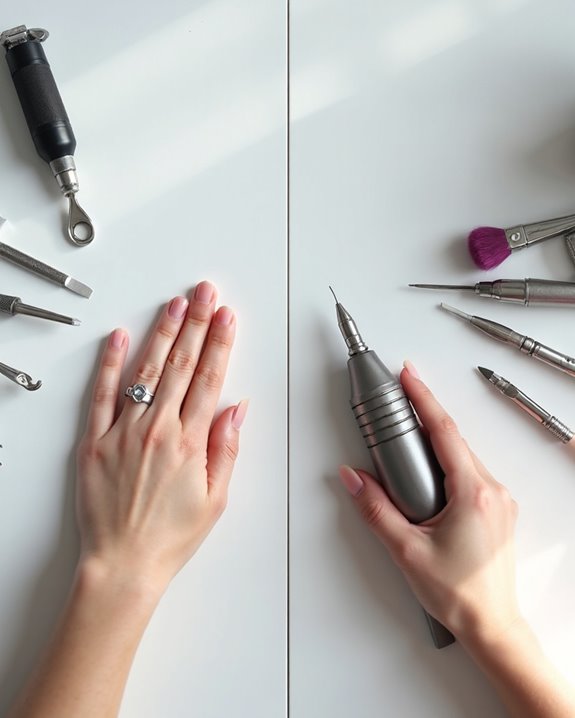
When deciding whether a nail drill is necessary, individuals must carefully consider their skill level and intended usage, as beginners and professionals have distinctly different requirements for nail care tools. Beginners typically achieve better results with traditional hand filing techniques, which provide greater control and greatly reduce the risk of accidentally damaging natural nails during the learning process. Electric file usage requires specific training and practice before becoming proficient.
For professionals serving multiple clients daily, nail drills offering speeds up to 35,000 RPM prove indispensable for efficient service delivery, whereas beginners need only 25,000 RPM for basic tasks if they choose to use an electric file. Additionally, the investment considerations differ substantially—beginners can start with $30 models, while professionals should budget up to $100 for equipment that withstands frequent, intensive use.
To aid beginners, models like the COSLUS Cordless Electric Nail Drill offer stepless speed control, allowing for gradual and safe adjustments during nail care.
Speed Matters: Understanding RPM Requirements
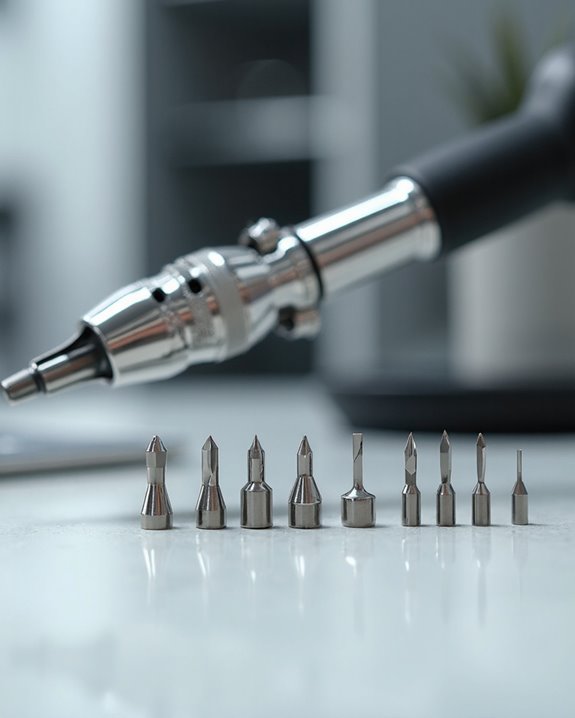
How rapidly a nail drill rotates fundamentally determines its ability to perform different nail care tasks, with RPM (Rotations Per Minute) serving as the critical measurement for equipment selection. Beginners should consider tools operating at 18,000-25,000 RPM, which provide sufficient power for basic shaping and poly gel removal while minimizing discomfort during the learning phase of proper use.
Professional technicians benefit from higher-powered drills, with models like the Geneviere (30,000 RPM) and Stephanee (35,000 RPM) enabling efficient work on multiple clients. The increased speed allows professionals to shape your nails with precision while reducing service time compared to manual filing. When using the nail drill, matching the RPM to the specific application guarantees both safety and ideal performance, with higher speeds reserved for demanding tasks like acrylic shaping and intricate design work.
For optimal results in professional settings, many advanced models achieve 35,000 RPM to handle tough materials like acrylic nails effectively.
Cost Analysis: Investment vs. Value Over Time

The price tag attached to nail drills represents more than a simple purchase cost—it reflects a strategic investment decision that balances immediate expenditure against long-term utility. While beginners can start with a $30 model as recommended by Makartt, professionals often find that investing up to $100 yields substantial returns through time efficiency when performing services.
Quality drills, particularly those designed to avoid over-filing and damaging the nail, typically last several years, effectively distributing the initial expense across thousands of services. When comparing a high-RPM drill’s performance against manual methods, professionals can quantify time savings that directly impact their bottom line. Many suppliers offer exclusive deals on premium models, making higher-end equipment more accessible for those who regularly use a nail drill professionally, ultimately transforming what appears as an expense into a revenue-generating asset.
The Learning Curve: Mastering Proper Technique

Mastering a nail drill requires dedicated practice and proper instruction, representing one of the most significant challenges for both aspiring nail technicians and enthusiasts alike. Beginners should enroll in specialized training programs, such as NSI drilling courses, where they learn to properly hold the drill and maintain constant motion to prevent damage to your nails. The technique requires moving the drill in gentle, circular patterns at appropriate speeds—up to 25,000 RPM for novices—to avoid concentrated filing in one area.
Practicing initially on one’s own nails helps build confidence before working on clients. Technical resources, including books on carbide bits and their applications, can accelerate proficiency development. High-quality equipment from manufacturers like Kupa, paired with consistent practice, allows users to master specialized techniques like backfills within several focused sessions.
Comparing Hand Filing to Electric Filing
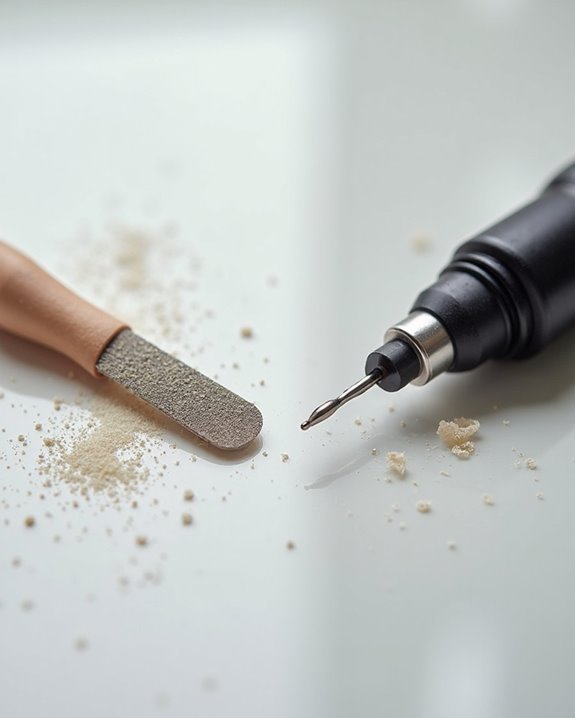
When comparing hand filing to electric filing, nail technicians must consider the efficiency and application requirements of each method to determine the most appropriate technique for specific situations. Electric files excel at removing nail bulk and correcting imperfections from brush work more efficiently than manual nail files, especially when debulking thicker enhancements.
While both methods can potentially damage nails if misused, hand filing lacks the speed advantages of electric options when shaping thick nails or removing the bulk of enhancement materials. Professionals typically opt for electric files for faster prep and shaping once they’ve mastered proper technique, whereas beginners may find manual nail files safer and more intuitive. For minimal filing needs with thin enhancements, hand filing remains sufficient; however, electric options provide significant time-saving benefits for thicker applications, despite generating more dust requiring cleanup.
Essential Bits and Attachments Worth Having
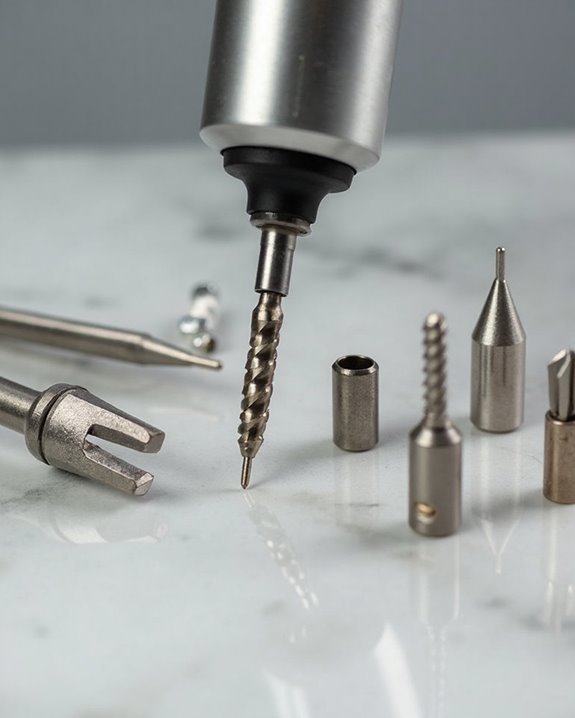
Selecting appropriate bits and attachments for a nail drill transforms basic electric filing into precision nail artistry, enabling technicians to perform a wide range of specialized techniques with greater efficiency. Carbide bits deliver exceptional durability when cutting and shaping gel polish layers, while diamond bits excel at removing product build-up without excessive pressure. For work around the cuticle area, safety bits prevent over-filing and protect the natural nail bed from damage during routine maintenance.
Ceramic bits generate less friction and heat, making them ideal for gentle filing of natural nails where comfort is paramount. Ball bits provide targeted access to challenging areas like sidewalls and underneath the nail edge, particularly useful when prepping for backfills. Each attachment serves a specific purpose, allowing professionals to customize their approach based on the service requirements.
When a Nail Drill Makes the Most Sense
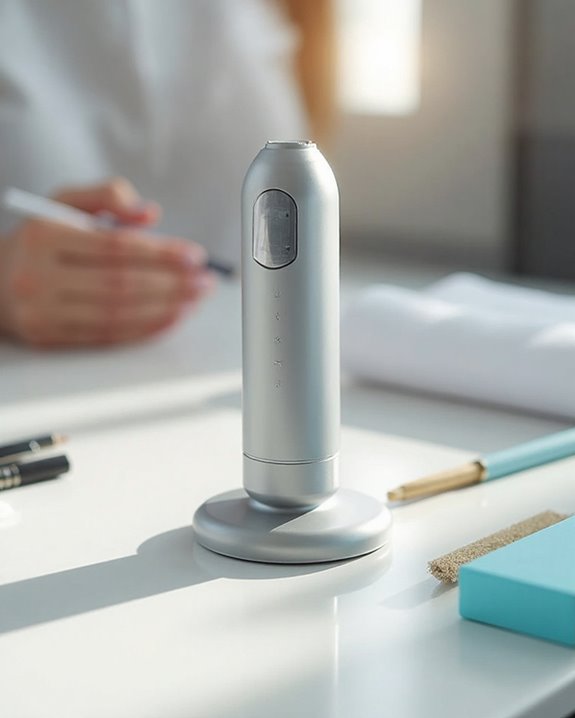
With the right attachments in hand, determining whether to invest in a nail drill becomes the next logical consideration for both professionals and enthusiasts. For professional technicians managing multiple clients daily, high-powered models reaching 35,000 RPM prove indispensable when shaping acrylic and gel nails, greatly reducing the time spent on each service.
The device becomes particularly valuable for specialized applications, including intricate nail art, backfills, and sculptured nail designs. Technicians working with thick enhancements will find 30,000 RPM drills essential for efficient correction and debulking. Beginners may benefit from lower-speed options up to 25,000 RPM for poly gel removal and basic shaping. When clients with longer nails require precision work around cuticles or underneath the nail, electric files offer the control and efficiency that manual files cannot match.
Safety Considerations for Long-Term Nail Health
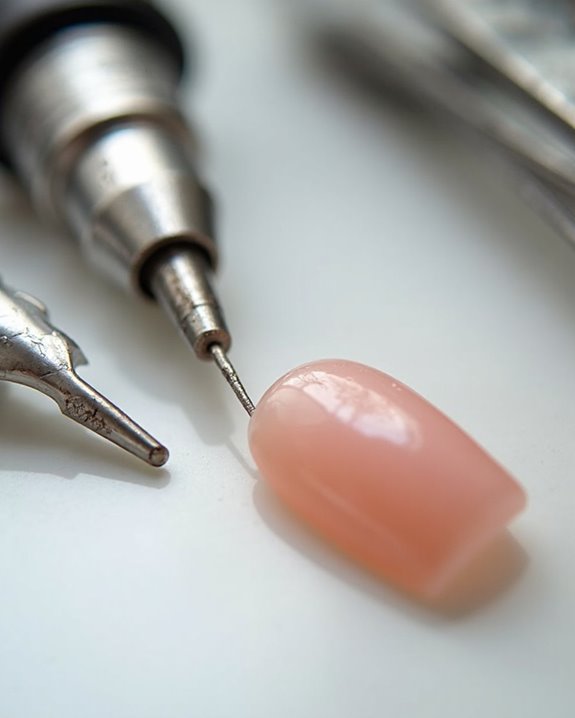
Why do some nail enthusiasts experience permanent damage despite regular manicures? Often, the culprit is improper electric nail drill technique that causes “rings of fire” or excessive thinning of the nail plate, compromising structural integrity over time.
When incorporating an electric drill into your nail care routine, it’s important to avoid keeping the bit stationary on any area. Maintaining constant motion prevents heat buildup and friction that can irreversibly damage the nail bed. For nails at home, beginners should select fine or medium grit bits and operate at speeds below 25,000 RPM to minimize trauma. Coarse or metal bits can cause painful burns and long-term weakening of the natural nail.
Professional training, such as NSI drilling courses, teaches proper pressure techniques and safe operation principles that preserve nail health for years to come.
The Most Versatile Nail Drill Features to Look For
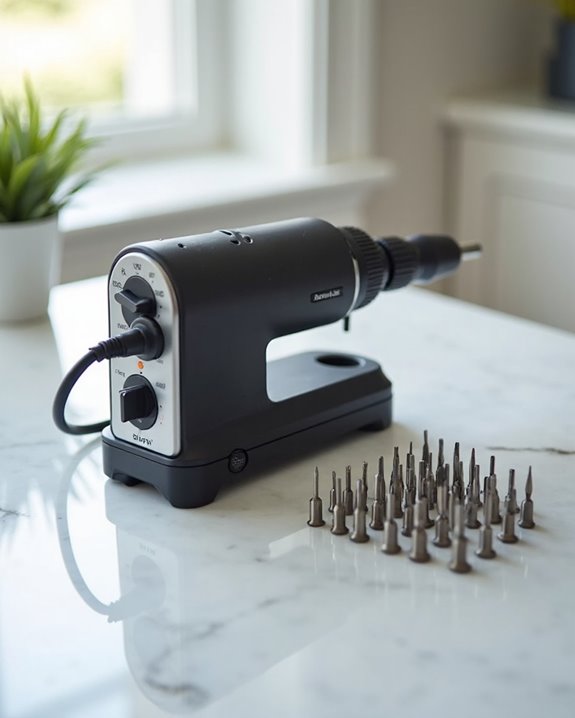
After understanding proper safety techniques, nail enthusiasts must consider which features create the most functional and adaptable nail drill. The Right Nail drill should offer adjustable RPM settings reaching 35,000, providing flexibility for gentle shaping or intensive work on acrylics and nail polish applications. Professionals benefit from drills supporting multiple bits—carbide, diamond, and ceramic—each designed for specific functions while preserving nail integrity.
Hands-free operation through foot pedal controls enables technicians to maintain workflow efficiency without interruption, an essential feature covered in most brands’ Privacy Policy regarding user experience. Portable designs with convenient features like belt buckles facilitate mobility for salon and traveling technicians. Quality investments between $30-$100 from reputable manufacturers guarantee compatibility with accessories and long-term reliability, making the drill versatile for beginners and experienced professionals alike.
Frequently Asked Questions
Are Nail Drills Necessary?
Nail drills spark a necessity debate among technicians. While offering speed benefits for professionals managing multiple clients, they aren’t salon essentials for everyone. Many achieve quality results using home alternatives like manual files, especially beginners.
Can You Remove Acrylic Nails Without a Drill?
Over 60% of nail damage occurs during improper acrylic removal. Yes, acrylic nails can be removed without a drill through Acrylic Soaking, Chemical Methods, Natural Removal, and Safety Techniques that protect the nail bed.
Do You Need to Drill Holes for Nails?
No, drilling holes isn’t necessary for most nail services. Surface prep can be achieved with alternatives like gentle filing techniques. Material choices determine preparation methods, while hammer methods are irrelevant in professional nail enhancement applications.
Can I Use a Nail File Instead of a Nail Drill?
Yes, manual nail files offer adequate file speed for natural nails while providing greater file comfort. They achieve acceptable surface finish for home use and maintain tool hygiene without the training electric drills require.





